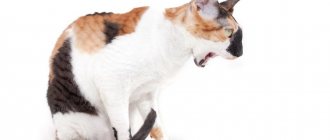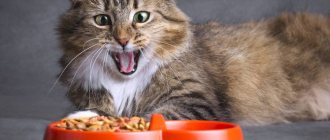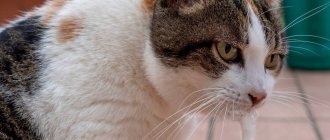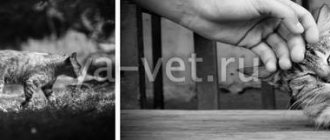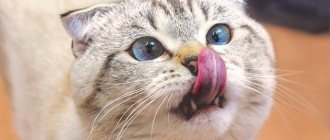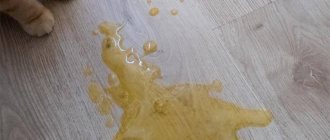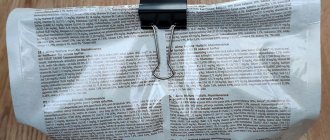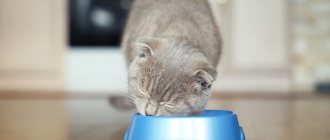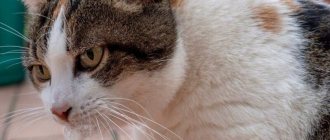September 16, 2019
Vomiting after eating, no matter whether it is dry food or not, has happened to every pet at least once in its life, and it is not always dangerous. However, if such episodes happen regularly, then in no case should you let the situation take its course. Let's understand the reasons for this phenomenon, try to separate the wheat from the chaff and develop a strategy for action if a cat vomits after dry food.
Poor quality diet
This is the first thing that comes to the owner’s mind if he sees that, as soon as he leaves the bowl of dry food, his pet gets rid of what he has eaten. Indeed, like any food product, ready-made industrial rations can deteriorate due to improper storage or after the expiration date. Therefore, it is worth checking the date on the packaging, and also smelling the granules - a sour, rancid smell indicates that the degree of oxidation of fats in the feed has already gone beyond certain limits, and it is better to get rid of such a product.
Burps food
Cats who eat only dry food often burp almost immediately after eating. When dry food mixes with the contents of the stomach, it expands and causes discomfort.
Something as harmless as a form of dry food can cause spit up. Try different forms of dry food to see if your kitten can handle pellet-shaped food versus star- or square-shaped kibble.
© shutterstock
Food intolerance
This condition develops due to the inability of the body's enzyme system to digest one or another component of dry food. As a rule, it occurs immediately upon a new diet and is accompanied not only by vomiting, but also by diarrhea. Is food intolerance a signal for an immediate diet change? Not always.
Very often, the pancreas simply needs time to adapt to the new diet and begin producing enzymes in the required quantities. For example, if your cat previously ate dry food with a low meat content for a long time, and now you decide to switch it to a diet with a large amount of meat ingredients, then naturally the stomach cannot digest it right away. That is why it is recommended to make the transition to a new diet gradually, gradually mixing the new food into the old diet and increasing its share every day until complete replacement.
In some cases, the process may be helped by taking enzyme preparations as prescribed by a veterinarian. You should also consult with him if the transition is carried out correctly, but the vomiting does not stop, in order to identify the component causing food intolerance and avoid it in the future.
Differences between vomiting and regurgitation
A cat's vomiting of undigested food is the most common sign of illness. There are processes that look similar to vomiting, but which are not vomiting. The owner should differentiate between regurgitation and vomiting in order to describe the symptoms to the veterinarian. This is what will help the doctor make the correct diagnosis.
Vomiting is a reflex eruption of stomach contents. Its predecessor is nausea, which worries the animal. The cat begins to meow and back away, as if it cannot find a place for itself. At some point the pet hunches over and lowers its head. The owner may notice excessive salivation. Vomiting is accompanied by characteristic sounds. The masses contain remnants of undigested food, as well as bile.
Attacks occurring once every 4-5 days are considered normal. However, to understand the causes of vomiting, you need to reconsider your pet’s diet.
Sometimes cats vomit food, but owners mistake it for vomiting. Regurgitation is a process that occurs due to a spasm in the stomach. It begins immediately after eating or drinking water. Before and during regurgitation there is no salivation and nausea. The food comes out undigested, with an unpleasant odor and streaked with blood.
Most often, regurgitation is not of a threatening nature, but if the process is repeated several times a day, then the pet should be shown to a doctor.
Cat vomits from overeating dry food
This is a very common cause of vomiting after dry food, resulting from excessive fullness of the stomach, which cannot cope with the digestion of a large volume of food. Such situations arise among owners who do not adhere to the daily norms of dry food recommended by the manufacturer and pour granules into a bowl without measure, and most often among those who really like to feed their pet tasty food throughout the day. In such situations, dry food, as a rule, becomes only the last straw that overflows the “cup of patience” of the stomach.
Establish a feeding regime for your pet and do not overfeed your cat, because this risks not only vomiting, but also serious diseases caused by excess weight and obesity.
Mixing different foods
Another reason for vomiting is also associated with excessive “concern” for your beloved cat to eat as plentifully and variedly as possible. Trouble is almost inevitable when other food is added directly to dry food, which simply cannot be digested normally along with it. For example, adding raw meat to dry food or even giving it to your cat shortly before eating can cause vomiting because raw food takes much more time and enzymes to digest. Digestion becomes seriously difficult and may stop completely, resulting in vomiting.
Adding milk to dry food or giving it immediately before eating is also a bad idea. If the cat does not have enough lactase to digest this product, the result will be the same. A similar reaction can occur from adding broth or (real case!) liquid from a can of canned tuna, and so on. Separately, dry food and all these products can be digested, but together they cannot.
We advise you not to mix dry food and other foods in the same bowl, and if you still want to diversify your cat's diet, then choose complete wet food for it and feed it separately from dry food at different meals.
Mistakes when organizing feeding
First of all, you should think about how well the feeding is organized. One of the following problems may be occurring.
The cat is vomiting because he has eaten too much
If the owner does not follow the manufacturer's recommendations on feeding standards, the cause of vomiting in the cat may be simple overeating. Practice shows that most of us tend to underestimate the nutritional value of dry foods: they seem light and “frivolous”, which means that you need a lot of them to satiate. Reasoning in this way, owners sometimes exceed the daily norm several times, without thinking about the consequences.
If the pet is not prone to overeating, he simply leaves the excess in the bowl until the next meal. However, not all cats show such moderation: some of them are ready to eat and eat until they feel that their stomach is full to capacity.
Once in a humid environment, food particles swell significantly, which causes heaviness in the stomach and vomiting. To avoid this effect, you should adhere to the dosages recommended by the manufacturer, and also divide the daily amount of food into at least two equal parts, one of which is given to the cat in the morning, the other in the evening.
The cat swallows food particles too quickly
Even those owners who feed their pet strictly according to the norm may encounter this problem. Often, this behavior of a cat is due to competition (if he is not alone in the house) or a period of forced malnutrition he has experienced.
If your cat is vomiting after dry food and you notice that he is eating too quickly, try following these rules:
- feed him separately from other cats and dogs, in a quiet place where children do not run around and no one disturbs him;
- buy a bowl equipped with ridges that slow down the absorption of food;
- reduce the volume of a single portion using more feedings.
Abrupt transfer to another brand of food
If your cat is vomiting from new dry food, it is possible that the change is too drastic. It is not for nothing that there is a recommendation that a new product should be introduced gradually, mixing it with the old one over a week or two. The problem is especially relevant when there is a significant difference in the composition of diets: for example, one consists mainly of cereals, and the second - of meat. Obviously, the latter is better, but the cat’s enzymatic system needs time to adapt to the absorption of animal protein in large quantities.
Dry food is expired or spoiled
If a cat is vomiting from dry food, it is necessary to exclude this cause. If the packaging is still intact, check the expiration date written on it. Even if the date is normal, the food can still be spoiled due to non-compliance with storage conditions: in an excessively warm or humid room, in light, in an open bag. Carefully inspect and smell the food: mold, rancid or sour odor of the granules indicate their unsuitability for feeding a cat. In this case, it is safer to throw away the entire package and open a new one.
To avoid encountering spoiled food in the future, be careful when purchasing it:
- check the expiration dates and keep in mind that a large package cannot be consumed quickly by one cat (it is advisable to use the food within 3 months after opening);
- Do not buy dry food in bulk or in damaged packaging, even if they are offered at a big discount.
Unsuitable dry food
It is rare, but it happens that completely benign dry food is simply not suitable for a cat, causing so-called food intolerance. An additional manifestation of this condition is stool disorder. In this case, the problem really lies in the contents of the bowl. But please note that the cause of vomiting is not all dry food, but its individual component. Typically a source of protein. By choosing a diet that does not contain the problematic ingredient, you can continue feeding your cat dry food without any problems.
Dry food was given along with another product
It is quite possible to provoke vomiting in a cat if you mix dry food with natural products, the digestion of which proceeds differently. For example, the breakdown of raw meat requires a more acidic environment and a longer period of time than the digestion of dry food, the proteins in which are denatured. Milk also interferes with the normal passage of feed through the gastrointestinal tract, since most adult cats do not have enough of the appropriate enzyme to digest it.
Mixing two incompatible foods stops the digestive process. Undigested food lingering in the stomach is regarded by the body as a potential threat, and it rushes to get rid of it. Therefore, if a cat vomits after feeding, dry food should not be mixed with anything.
Cat vomits after dry food from “greed”
Rapid, greedy absorption of food can also cause vomiting, because with such zeal too much air is swallowed, which fills the stomach and prevents normal digestion of food. Of course, dog owners are more likely to encounter this problem, because these animals have developed an instinct to eat quickly, because, as they say, in a large flock “they don’t snap their beaks.” But single cats can also find themselves in a situation where they need to eat food as quickly as possible, for example, if there are several pets, and among them there are those who strive to encroach on the contents of their neighbor’s bowl.
It is best to divide the dining rooms for cats, if not into different rooms, then at least into different corners or levels, for example, feed one on the floor, another on the windowsill, etc.
How to treat vomiting in a domestic cat?
Vomiting may be a sign of a serious infection. That is why animals, regardless of age, need to be vaccinated to prevent the development of feline diseases. If, despite the actions taken, the reduction in the amount of food, the cat continues to vomit, it must be shown to a veterinarian.
How to treat vomiting in a domestic cat:
- To conduct research, animal owners are asked to take an x-ray. Indeed, often the cause of vomiting is the entry of foreign objects into the digestive organs. This could be a children's construction set or parts from small toys that the animal can swallow along with food. Foreign objects irritate the walls of the stomach, causing severe cramps and vomiting. This is a way to get rid of a foreign object that is inside the abdominal cavity.
- Please note that in case of helminthic infestation, in no case should you give a large amount of antiparasitic drugs. This applies to animals that have lived on the street for a long period of time and are underweight, but at the same time they have a bloated stomach.
- When an anthelmintic drug acts, a large number of toxic components are formed in the body as a result of the breakdown of worms. It is these toxic substances that can kill an animal, especially if it is a kitten. Therefore, give such remedies in doses, in small portions. It is better to consult a veterinarian to ensure that you follow the required dosage and in no case exceed the permissible limit.
Hairballs, or bezoars
The problem affects all cats, but more so long-haired ones. As a result of daily licking, they swallow too much hair, so that it cannot be eliminated naturally, but accumulates in the stomach and intestines, forming dense clumps. When the stomach is empty, the cat may not be bothered by anything, but as soon as it eats, the volume of the stomach, along with the bezoars, increases so much that normal digestion becomes impossible and vomiting occurs. Regular brushing of your pet will help to cope with this problem, as well as special pastes for hair removal, which it is advisable to give at least once a month, and more often during the molting period.
Worm infestations
Internal parasites can also cause vomiting after eating, especially if there are so many of them that they fill not only the intestines, but also the esophagus. At risk is any cat that does not regularly (once a quarter) receive anthelmintic medications. Naturally, better late than never, but in such advanced cases it is better to consult a doctor for a treatment regimen, because abruptly getting rid of a large number of helminths threatens to poison the body.
It is also worth remembering that vomiting is already an extreme symptom; helminthic infestation can be noticed much earlier: it manifests itself in gastrointestinal disorders, deterioration in the condition of the pet’s coat and general condition. Finally, worms can be noticed in a cat’s excrement if you catch the moment a new generation of parasites exits into the external environment to resume the cycle. But we repeat, it is better not to let this happen, but to carry out preventive measures in time.
What symptoms require you to go to the clinic?
If the cat vomits food once, it is too early to panic. You should pay attention to the pet’s condition: whether its eyes are shiny, whether its nose is cold, what mood it is in - lethargic or active. Perhaps everything is fine with your health, but vomiting is caused by overeating.
How much dry food does a cat need per day: table
If a cat vomits food regularly, it is accompanied by poor health and impurities of blood or bile in the rejected masses, the animal should be taken to a doctor for examination. Especially if the vomit is yellow or green.
If this cannot be done in the near future, you should provide first aid yourself. It consists of limited consumption of water and food: the latter is fed in small pieces every 2 hours. Only easily digestible foods are suitable: boiled chicken, cottage cheese or baby food.
Important! Don't put off going to the clinic. Regular vomiting can be a signal of dangerous diseases.
Urgent medical attention is required if:
- vomiting continues for more than a day;
- the pet refuses food and water;
- the rejected masses contain admixtures of mucus or blood;
- The cat’s well-being and mobility deteriorate.
Binge eating
Don't start the disease!
Vomiting can be a symptom of a large number of diseases, primarily acute poisoning, foreign body entering the stomach due to accidental ingestion, diseases of the gastrointestinal tract, liver, and pancreas. It often accompanies various infections, many of which pose a danger to the life of the animal. Therefore, if vomiting recurs constantly or very often, then you need to consult a doctor so as not to start the disease. In this case, you should immediately prepare yourself for a serious examination - taking tests and following all the specialist’s instructions.
Uncontrollable (incessant) vomiting, accompanied by a sharp deterioration in the pet’s well-being, is a reason not only to contact, but to immediately run to the doctor, because such acute conditions require immediate, sometimes surgical, intervention.
Variations of vomiting
Vomit may contain more than just pieces of undigested food. Depending on the "additional" components, a specific type of problem can be suspected .
- If you vomit with white foam. It does not pose a danger in itself, but if it appears constantly, it requires consultation with a veterinarian.
- Vomits with bile. This symptom indicates problems with the functioning of the gallbladder or liver. If the vomit contains, in addition to pieces of undigested food, both bile and white foam, then the animal needs to be examined and receive specialized treatment.
- Vomits blood. The symptom indicates the development of a serious condition caused by damage to the gastrointestinal mucosa. It is necessary to examine the cat's mouth. There is probably a wound in it that is bleeding.
- Vomits green or yellow mass with greenish inclusions. This is a symptom of a serious pathology or it may indicate a developed intestinal obstruction. In this case, you cannot do without the help of a veterinarian.
If a small kitten vomits - regardless of the composition of the vomit, the presence/absence of food in it - it needs to be shown to a doctor immediately.
